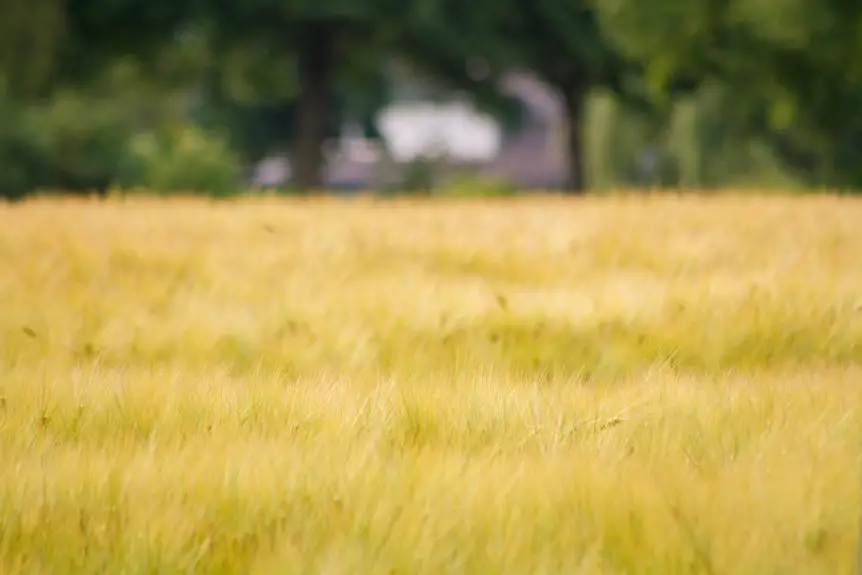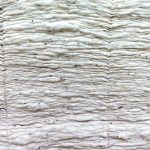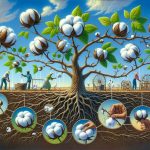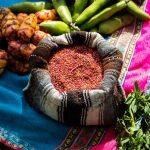Like a shadow lurking behind a bright facade, the land use footprint of textile crops often goes unnoticed. You might think cotton reigns supreme, but the environmental costs are staggering. As you explore the various fibers we rely on, consider how their cultivation practices impact our planet. Are there better alternatives out there? The answer could reshape the future of the textile industry.
Table of Contents
Key Takeaways
- Cotton is highly resource-intensive, requiring approximately 2.5 acres of land to produce one bale.
- Synthetic fibers, derived from petroleum, contribute to land degradation and pollution during extraction.
- Monoculture practices in cotton farming lead to soil degradation and reduced biodiversity.
- Sericulture, utilizing mulberry trees, has a smaller land footprint and supports biodiversity.
- Heavy chemical use in conventional textile crops pollutes soil and waterways, impacting local ecosystems.
Overview of Textile Crop Land Use
When you consider the impact of textile crops on land use, it becomes clear how significant this sector is to agriculture and the environment.
Textile crops, including cotton, flax, and hemp, require vast tracts of land for cultivation. This demand often leads to deforestation, soil degradation, and biodiversity loss, which undermine the ecosystems around them.
You might be surprised to learn that these crops also consume substantial water resources, further straining local environments.
Sustainable practices, such as crop rotation and organic farming, can mitigate some of these impacts.
However, it’s essential for you to understand that the choices made in textile crop production directly influence land use and the health of our planet.
Your awareness can drive demand for more sustainable practices in this critical sector.
Cotton: The Most Land-Intensive Crop
Cotton stands out as one of the most land-intensive textile crops, demanding extensive fields to produce the fibers that have become essential in our daily lives. You might be surprised to learn that cotton requires about 2.5 acres of land to yield just one bale.
This land use is driven by the crop’s need for large amounts of water and nutrients, making it a resource-intensive choice for farmers. Additionally, cotton farming often involves monoculture practices, leading to soil degradation and reduced biodiversity.
As a consumer, you should be aware of the environmental impact associated with cotton production. By understanding its land use footprint, you can make more informed choices about the textile products you buy and support more sustainable practices in the industry.
The Impact of Synthetic Fibers on Land Use
Synthetic fibers might seem like a solution to land use issues, but their production comes with serious consequences.
You may not realize that oil extraction for these materials leads to pollution and indirectly impacts land resources.
To address these challenges, we need stronger environmental regulations that hold producers accountable.
Oil Extraction Pollution
As you explore the impact of textile production on the environment, it’s crucial to take into account how oil extraction pollution from synthetic fibers affects land use.
The process of extracting oil for synthetic fibers leads to significant environmental degradation that directly influences land use.
Consider these key points:
- Soil Contamination: Harmful chemicals seep into the soil, reducing its fertility.
- Water Pollution: Oil spills and runoff pollute local water sources, harming ecosystems.
- Biodiversity Loss: Habitats are destroyed, leading to a decline in wildlife and plant species.
- Greenhouse Gas Emissions: The extraction process contributes to climate change, further impacting land usability.
Recognizing these issues helps you understand the broader implications of synthetic fiber production on our planet.
Indirect Land Impact
While evaluating the land use impact of textile production, it’s essential to recognize how synthetic fibers indirectly affect ecosystems and agricultural practices.
When you choose synthetic textiles, you’re not just considering the materials themselves; you’re also impacting land use in various ways. The production of synthetic fibers like polyester relies heavily on petrochemical processes that can lead to habitat destruction and pollution.
This extraction often compromises valuable land that could support biodiversity. Additionally, the demand for synthetics contributes to a cycle of overconsumption, prompting more land to be cleared for resource extraction.
Environmental Regulations Needed
Given the significant impact synthetic fibers have on land use, enforcing stricter environmental regulations becomes essential.
You mightn’t realize that synthetic fibers contribute to deforestation, soil degradation, and water pollution. By implementing regulations, you can help mitigate these issues and promote sustainable practices.
Here are some key areas to focus on:
- Limiting Fiber Production: Set caps on the amount of synthetic fibers produced annually.
- Recycling Initiatives: Encourage the development of recycling programs for synthetic textiles.
- Sustainable Alternatives: Promote research and investment in eco-friendly fabrics.
- Transparent Labeling: Require brands to disclose the environmental impact of their products.
These measures can lead to healthier ecosystems and a more sustainable textile industry, ultimately benefiting you and future generations.
Sericulture: Sustainable Land Use Practices
Sericulture, the cultivation of silkworms for silk production, offers a unique opportunity to promote sustainable land use practices. By utilizing mulberry trees, which require less water and can thrive in various soil types, you can minimize resource depletion.
This method reduces the need for chemical fertilizers and pesticides, creating a healthier ecosystem. Furthermore, sericulture supports biodiversity by providing habitats for various species, enhancing overall environmental health.
You’ll find that integrating agroforestry with sericulture allows for efficient land use, as you can grow food crops alongside mulberry trees. This synergy not only maximizes productivity but also guarantees that local communities benefit economically while preserving their environment.
Embracing these practices can lead to a more sustainable future for silk production.
Cellulosic Fibers and Forest Land Requirements
Cellulosic fibers, derived from plants like cotton, flax, and hemp, play a significant role in the textile industry, but their cultivation often requires extensive forest land. This demand can lead to deforestation and habitat loss, raising concerns about sustainability.
Here are some key points to reflect on:
- Cotton farming, while popular, consumes vast amounts of water and land.
- Flax, used for linen, needs specific soil types, often leading to land competition.
- Hemp offers a more sustainable alternative but still requires land that could support forests.
- Over-reliance on these fibers can impact biodiversity and ecosystem health.
Understanding these factors is essential as you weigh the environmental implications of the textiles you choose to support.
Livestock and Grassland Utilization
While you may not think of livestock as directly related to textiles, their role in grassland utilization is vital for sustainable practices. Grazing animals help maintain grassland ecosystems, promoting biodiversity and preventing overgrowth. This practice can contribute to healthier soils, which are important for growing fiber crops.
Here’s a quick overview of livestock’s impact on grassland utilization:
| Livestock Type | Grassland Benefit | Textile Connection |
|---|---|---|
| Cattle | Soil aeration | Leather production |
| Sheep | Weed control | Wool production |
| Goats | Browsing | Specialty fibers |
| Horses | Nutrient cycling | Leather and textiles |
| Bison | Ecosystem balance | Natural fibers |
Environmental Consequences of Textile Crop Production
When you think about textile crop production, consider the significant water consumption it requires and the pollution it generates.
These issues can lead to toxic environments that affect both ecosystems and human health.
It’s essential to understand how these factors impact our planet as we continue to rely on these crops for clothing and other goods.
Water Consumption Concerns
As the demand for textile crops rises, so do the concerns surrounding their water consumption and environmental impact. You might be surprised to learn just how much water these crops require, leading to potential depletion of local water resources.
Here are some key points to contemplate:
- Cotton can consume over 7,000 liters per kilogram produced.
- Hemp is more water-efficient, using around 600 liters per kilogram.
- Linen, derived from flax, requires approximately 1,200 liters per kilogram.
- Synthetic fibers often rely on petroleum extraction, which also consumes significant water.
Understanding these figures helps you appreciate the balance needed between textile production and sustainable water use.
Pollution and Toxicity Issues
The environmental impact of textile crop production extends beyond just water consumption; pollution and toxicity issues are significant concerns as well.
When you think about cotton or synthetic fiber production, it’s essential to take into account the heavy use of pesticides and fertilizers. These chemicals can contaminate soil and waterways, harming local ecosystems and drinking water sources.
Additionally, the manufacturing processes often release harmful pollutants into the air, affecting both worker health and surrounding communities.
You may not realize that even the dyes used in textiles can be toxic, posing serious risks during and after production.
Biodiversity and Ecosystem Impacts
While textile crop production plays an essential role in the global economy, it also poses significant challenges to biodiversity and ecosystem health.
The expansion of land for these crops often leads to habitat destruction, threatening various species. Here are a few impacts to take into account:
- Loss of native plants and animals through monoculture practices.
- Soil degradation and reduced fertility due to continuous cropping.
- Increased pesticide use harming non-target species and local ecosystems.
- Water scarcity and pollution affecting aquatic habitats.
You need to recognize that these consequences can disrupt ecological balance, making sustainable practices vital.
Economic and Social Implications of Land Use
When you consider the economic and social implications of land use for textile crops, employment opportunities in sericulture stand out.
As the market trends in textiles evolve, they directly impact job creation and sustainability in local communities.
Understanding these dynamics helps you appreciate the broader effects of land use decisions.
Employment Opportunities in Sericulture
Sericulture offers a range of employment opportunities that not only boost local economies but also support sustainable land use practices.
Engaging in sericulture can provide you with various roles that cater to different skill sets and interests. Here are some key employment opportunities in this field:
- Silk Farmers: You can cultivate mulberry trees and raise silkworms, contributing directly to silk production.
- Processing Workers: In silk processing facilities, you’ll help turn raw silk into finished products.
- Research and Development: If you’re interested in innovation, you can work on improving sericulture techniques or developing new products.
- Educators and Trainers: Sharing knowledge about sustainable practices and techniques can empower new sericulturists.
Market Trends in Textiles
How do current market trends in textiles reflect the economic and social implications of land use?
As you explore the textile market, you’ll notice a shift towards sustainable and eco-friendly practices. Consumers increasingly demand transparency, pushing brands to adopt ethical sourcing and production. This trend can lead to a reduction in land use impacts, as companies prioritize organic and regenerative farming methods.
Additionally, the rise of circular fashion promotes recycling and upcycling, further decreasing the need for raw material extraction. However, while these trends foster environmental awareness, they also challenge traditional agricultural systems and labor practices.
Future Directions for Sustainable Textile Production
As the demand for sustainable practices grows, the textile industry must adapt to innovative approaches that prioritize environmental stewardship and social responsibility.
You can champion these changes by focusing on key strategies that support a greener future:
- Utilize organic and regenerative farming methods to reduce chemical usage and enhance soil health.
- Adopt closed-loop systems that minimize waste by recycling materials and repurposing fabric scraps.
- Invest in eco-friendly dyes and finishes to decrease water pollution and energy consumption.
- Promote fair labor practices by ensuring workers are treated ethically and compensated fairly.
Frequently Asked Questions
What Are the Top Countries Producing Cotton and Other Textile Crops?
Imagine vast fields swaying gently in the breeze. Countries like China, India, and the USA lead in cotton production, while nations like Bangladesh and Turkey thrive with other textile crops, weaving a colorful global tapestry.
How Does Organic Cotton Farming Compare in Land Use to Conventional Cotton?
When you compare organic cotton farming to conventional methods, you’ll find organic practices often use less land due to crop rotation and healthier soil, promoting sustainability while reducing the overall environmental impact of cotton production.
What Role Do Consumer Choices Play in Textile Land Use Impact?
Did you know that choosing organic textiles can reduce land use by up to 50%? Your choices directly influence agricultural practices, encouraging sustainable farming and minimizing environmental impacts, so think carefully about what you purchase.
Are There Any Textile Crops That Require Less Land Than Others?
Yes, some textile crops require less land, like hemp and organic cotton. By choosing these options, you can help reduce the land use impact of your clothing choices, promoting sustainability in the fashion industry.
How Can Farmers Transition to More Sustainable Textile Practices?
Did you know that sustainable practices can reduce water usage by up to 50%? To shift, you’ll focus on crop rotation, organic methods, and integrating technology that enhances efficiency while minimizing environmental impact.
- What Fabric Is Used for Chino Pants? A Detailed Guide - June 20, 2025
- What Fabric Did China Contribute to the World? Historical Impact - June 20, 2025
- What Fabric Are Chinos Made From? A Comprehensive Guide - June 20, 2025






